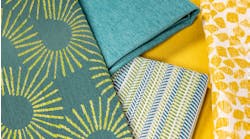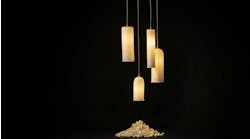Tradeshows in Europe, as a rule, tend to surprise American visitors. You slow down, take in the impressive hospitality—the food, the wine, the espresso—and find your head filled with endless numbers of global design options and new products.
Cevisama, the international ceramic tile fair held in early February in Valencia, Spain, is no exception. It’s a show influenced by tile’s deep history in the country; from the smallest artisanal workshops to the largest factories, tile is a family business in Spain, frequently passed down through the generations. You can see it in the friendly nature of the exhibitors and the pride they take in their product.
And yet, Spanish tile makers have also worked to solidify their position at the forefront of technology and design. That may be why Cevisama attracts more international visitors than any other tradeshow in the country, and a driving factor in the Spanish tile sector’s continued health, despite a lagging domestic economy.
Innovation and personalization seemed to be the overarching themes of the show for the thousands of designers, architects and specifiers who attended. Ink jet technology is becoming sharper and more vivid, allowing designers to push wood and stone looks into new territories with effects that can’t be found anywhere in nature, while the sheer number of patterns, mosaics and accent tiles on display made it feel like being in a giant candy store. Designers can now select tiles and patterns that speak directly to a client—the days of one-size-fits-all are long gone.
Here’s a brief overview of some of the other key trends and new products spotted at this year’s Cevisama show.
reclaimed wood
Spanish tile manufacturers continue to push the envelope with wood-look tiles; this year, it seemed like the big push was into reclaimed wood territory. These tiles can provide the same weather-worn appearance as nature, with the durability to keep it that way indefinitely. Manufacturers are also incorporating bright colors and graffiti styles into these tiles, allowing designers to create everything from the look of a Maine boat slip to something completely original.
Some of the notable collections spotted included the Tau Graffiti Collection, which captures the essence of the murals found in Spain’s northern city of Vitoria. Once plain walls that remained old and dirty, these surfaces now depict real artistic works. Each faux wood panel has a slight lift, as if it was hand-painted to achieve that effect. Likewise, the Sonar Collection from Aparici is the result of an innovative design approach that blends the warmth of wood with the contemporary look of cement. Other interesting takes on the trend could be seen in Faro from Vives and Timber by Peronda.
precious metals
Gold, silver and copper are weaving their way into tile design in a more sophisticated tone and with impressive technologies for mirrored effects and on-the-floor durability. Not just for the wealthy anymore, precious metals are being used in high-end commercial environments and luxury bath settings to create an elegant focal point.
One of the most striking examples came from Ceracasa, whose Absolute range blends semiprecious stones with subtle colors, gradients and fast graphics; its high-gloss polished finish offers a mirrored effect, bringing luminosity to any room. For designers looking to recreate the feeling of gold and silver as used in traditional wallcoverings, the Star Collection from La Platera provides a vintage metallic look that is also durable and easy to clean. Also notable is Velvet by Keraben, which features light color bases and a slight sheen to help increase luminosity.
vintage tiles
Vintage patterns are becoming popular among designers who are looking for the ultimate in personalization. Whether by adding centuries of patina through the art of ink jet printing or modernizing a traditional look with today’s gray and black palettes, manufacturers are looking to the past to lead us into the future.
Tassel, part of the 1900 Collection from Vives, takes its inspiration from the Art Nouveau trend of the early 20th century with a mixture of curves, organic shapes and symmetries. A similar look can be spotted in the ceramic tiles that make up Hidraulico from Peronda, which have been delicately crafted to recreate the encaustic cement tiles popularized in the Modernist era. Natucer also caught a lot of eyes with its Kubik line, which creates three-dimensional visual depth with playful patterns, as did the stark and beautiful Moving series by Aparici.
technology advances
Spanish tile manufacturers continue to innovate, with a big focus on thin tile that can be used as large-format countertops, building facades and even ceramic induction cooktops.
A prime example of this can be seen in TechLam countertops from Levantina. With a thickness of 3 to 5 millimeters, these tiles offer tremendous advantages in transport and installation.
It is more sustainable to ship and easier to install, requiring very little grouting; it can also be installed over existing flooring. The 3-millimeter thick Coverlam line from Grespania is another ultra-thin option ideal for surfacing and countertop uses.
The rise of new printing technologies and reactive glazes has enabled the creation of custom tiles and the incorporation of lifelike digital photography into murals. Porcelanosa showcased its ability to create custom mosaics inspired by a single photo, and Azteca showed off its technology with multiple lines of image-printed tiles, including a new series bearing the official logos for Spain’s much-loved football clubs in Barcelona and Madrid.
mix and match
Mix-and-match styles were prevalent at Cevisama, as designers look to mix patterns and finishes within spaces to create personalized looks for each project.
Some of the most popular products were those with a stone look and a rough-hewn finish, as if they had been fresh cut from a quarry; these were frequently paired with tiles featuring natural or semi-polished finishes. A notable example of this could be seen in Davos from Pamesa, a through-body porcelain tile offering a wide variety of looks and textures; visitors were also drawn to Bolonia by Mainzu, which showcases medieval patterns and bright color palettes. Also popular were patterns that took their inspiration from fashion textiles. Thanks to these innovative and beautiful options, no room will ever have to be the same.
Lori Dolnick is a vice president at Frank Advertising and works primarily with manufacturers in the design industry. Lori writes for several blogs in the industry and is active in social media as well as traditional marketing/public relations. She can be reached at [email protected].


